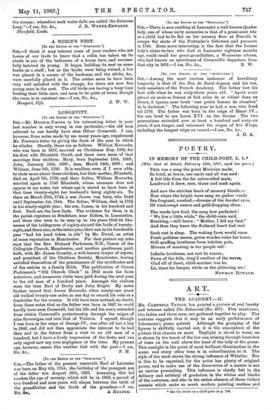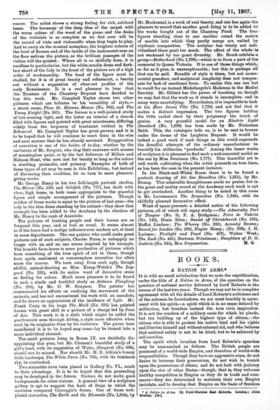ART.
THE ACADEMY.—II.
Ma. CAMPBELL TAYLOR has painted a picture of real beauty and interest called The Rehearsal (No. 487). Five musicians, two ladies and three men, are gathered together to play. The costume suggests that it may be an early performance of Schumann's piano quintet. Although the grouping of the figures is skilfully carried outs it is the atmosphere of the picture that charms us most. Daylight is about to wane, as- is shown by the touch of the low sun shining through branches of trees on the wall above the head of the lady at the piano. This sunlight is the point of moat brilliant illumination in the scene, and every other tone is in subordination to it. The style of the work shows the strong influence of Whistler. Nor is this to be regretted, for the artist has plenty of original power, and to make use of the discoveries of a master is not an unwise proceeding. This influence is chiefly felt in the delicacy and subtlety of gradation in the whites and blacks of the costumes, and also in the entire absence of those violent accents which make so much modern painting restless and
• See the letter on a elald.poet oa p. 756.
coarse. The artist shows a strong feeling for rich, subdued tones. The harmony of the deep blue of the carpet with the warm • colour. of the wood of the piano and the desks of the violinists is as complete as we feel sure will be the accord of viola and violoncello when they begin to play. And to carry on the musical metaphor, the brighter colours of the bowl of flowers and of the inside of the instrument-case on the floor enliven the picture, as the brilliant passages of the violins will the quintet.. Where all is so skilfully done, it is needless to particularise, but the white-muslin dress and dark- lace shawl of the lady in the front of the picture are of a high order of workmanship. The bead of the figure must be studied, for it is of great beauty and refinement, a beauty not without a suggestion of clear-cut profiles of the early Renaissance. It is a real pleasure to hear that the Trustees of the Chantn3y Bequest have decided to buy this work. Mr. Campbell Taylor shows two other pictures which are tributes to his versatility of style,— a street scene, Place St. Etienne, Meaux (No. 802), and The Young Knight (No. 501). The former is a well-painted study of late evening light, and the latter an interior of a church filled with figures and painted with great minuteness, differing widely from the largeness of treatment evident in The Rehearsal. Mr. Campbell Taylor has great powers, and it is to be hoped that he will continue to exert them in the wise and sane manner that he has already assumed. Exaggeration of execution is one of the faults of to-day, whether by the imitators of Mr. Sargent, who clog their canvases with masses of meaningless paint, or by the last followers of Millais and Holman Hunt, who care not for beautg So long as the colour is startling, prismatic, and primary. Examples of both 'of these types of art may be seen in this Exhibition; but instead of discussing their crudities, let us turn to more pleasure- giving works.
Mr. George Henry in his two fall-length portrait studies, The Mirror (No. 530) and Goldfish (go. 777), has dealt with clear, high tones, in both cases appropriate to the graceful figure and simple arrangement of the pictures. Though neither of these works is equal to the picture of last year—the lady in the blue dress standing by the cabinet—they show that strength has been added to the Academy by the election of Mr. Henry to the rank of Associate.
The pictures of hunting people and their horses are as frequent this year, and as bad, as usuaL It seems almost as if the horse had a malign influence over modern art, at least in some departments. The one painter who could make great pictures out of 'such subjects, Charles Purse, is unhappily no longer with us, and no one seems inspired by his example. The bumble farm-horse is more productive of pictures which have something of the true spirit of art in them, though here again. sentiment or commonplace execution too often mars the canvas. We turn away from such ugly, though skilful, animal-diawing as Miss Kemp-Welch's The Lag- gard (No. 336), with its entire want of decorative sense or feeling for colour. Much more pleasure is to be found in such a simile and truthful study as Alain= Ploughing (No. 288), by Mr. C. W. Simpson. The painter has -concentrated his efforts on realising the movement of the . animals, and has not encumbered his work with an anecdote, . and he shows an appreciation of the incidence of light. Mr. .Frank Craig in his large The Maid (No. 358) has painted :hontes with great skill in a picture of a charge led by Joan .of Arc. This work is in a style which might be called the suattrocento seen through Abbey, a style more effective when used by its originator than by his imitators. The power here manifested it is to be hoped may some day be turned into a more individual channel.
The small pictures hung in Room IX. are decidedly die- :appointing this year, but Mr. Clausen's beautiful study of a girl's head, with, its suggestion of Watts, Margaret (No. 688), should not be missed. Nor should Mr. M. E. Atkins's breezy little landscape, The White Farm (No. 703), with its luminous sky, be overlooked.
Two statuettes have been placed in Gallery No. VL, much to their advantage. It is to be hoped that this proceeding, may be developed in the. future. Statues do not make good backgrounds for other statues. A general view of a sculpture gallery is apt to suggest the hash of frogs to which the sacristan compared Correggio's fresco. One of these well- placed statuettes, The Earth and the Elements (No. 1,844), by Mr. Mackennal, is a work of real beauty, and one has again the pleasure to record that another good thing is to be added to the works bought out of the Chantrey Fend. The lour • figures standing close to one another round the matrix of marble into whioh they partly merge are united by rhythmic composition. The sculptor has -wisely not indi- vidualised these genii too much. The effect of the whole' not weakened by too great diversity. • Mr. Brock exhibits a group—Motherhood (No. 1,796)—which is to form a part of the memorial to Queen Victoria. It is one of those things which,• as far as it goes, is unexceptionable ; but this is perhaps all that can be said. Breadth of style is' there, ,but not monu- mental grandeur, and sculptural simplicity does not compen- sate for lack of emotional force. To realise this one has but to recall for an instant Michelangelo's Madonna in the Medici Sacristy. Mr. Gilbert has the power of touching us, though we may feel that the work as it stands is incomplete, and in many ways unsatisfying. Nevertheless, it is impossiblsto look at his Mors Janus Vita (No. 1,732) and not feel that it makes t distinct impression. The two figures holding the little casket show by their poignancy the touch of genius. A very graceful model for an Electric Light, Standard (No. 1,668) has been made by Mr. Nicholson Babb. This, the catalogue tells us,' is to be cast in bronze under the terms of the Leighton Bequest. It would be indeed a good work if such things as this could supersede the dreadful attempts of the ordinary manufacturer to beautify his utilitarian "products." Among the lesser works of sculpture it is pleasant to find Such a well-executed medal as the one by Miss Swainson (No. 1,777). This beautiful art is well worth cultivating when the artist proceeds on true lines, as has been the case in the present instance.
In the Black-and-Whits. Room there is to be found a portrait drawing of Sir Ian Hamilton (No. 1,351), by Mr. Strang. This admirable draughtsman needs no praise, but in. the great and motley crowd at the Academy such work is apt to get overlooked. Another thing to be noted in this room is Mr. Lawrenson's The Serpentine (No. 1,346), with its skilfully planned decorative effect.
Want of space prevents a detailed notice of the following pictures, all of which will repay study The Admiralty Port of Tangier (No. 9), F. A. Bridgman; Peire de Valerie (No. 143), Denis Eden ; Sunset of Christchurch (No. 195), Moffat Lindner; The Wherry (No. 220), Arneaby Brown; Bound for London (No. 236), Napier Hemy ; (No. 308), J. H. Lorimer; Firelight and Pearl (No. 407), Walter 'West; The Lock (No. 441), Bertram. Priestman; Daughters of D. G.
Guthrie (No. 544), Mrs. Swynnerton. H. S.











































 Previous page
Previous page